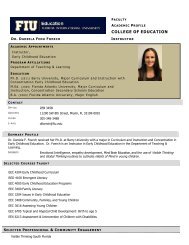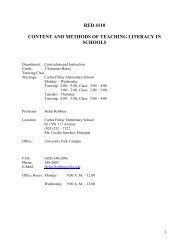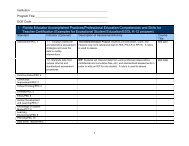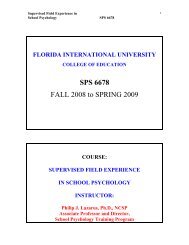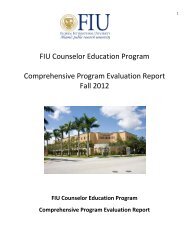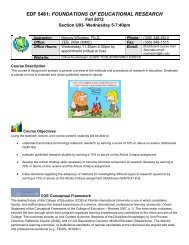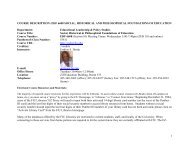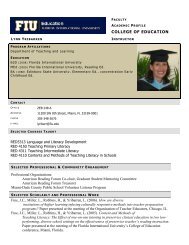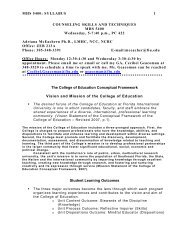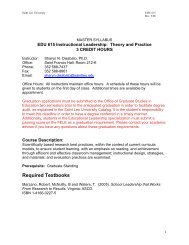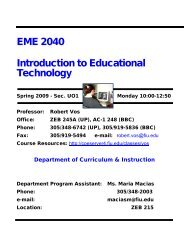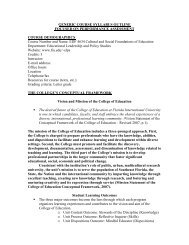2007 - College of Education - Florida International University
2007 - College of Education - Florida International University
2007 - College of Education - Florida International University
You also want an ePaper? Increase the reach of your titles
YUMPU automatically turns print PDFs into web optimized ePapers that Google loves.
4<br />
equation. 35<br />
Results<br />
Our purpose was to evaluate the acute effects <strong>of</strong> neuromuscular-training using three<br />
frequencies <strong>of</strong> HV on the accuracy and variability <strong>of</strong> elbow JPS. Table 1 presents the effects <strong>of</strong><br />
each vibration protocol on active elbow JPS. The 0Hz and 5Hz vibration protocols did not have<br />
a significant effect on accuracy (P>0.05), while the 15Hz vibration protocol significantly<br />
enhanced accuracy (decreased absolute error) (P≤0.05). The 0Hz vibration protocol did not<br />
significantly effect variability (P>0.05), while 5 and 15Hz vibration significantly enhanced<br />
variability (decreased variable error) (P≤0.05).<br />
Discussion<br />
We observed an acute enhancement <strong>of</strong> active elbow JPS (accuracy and variability) after<br />
neuromuscular-training using dumbbell vibration at 15Hz. This is the first report indicating<br />
vibration may enhance acute JPS when used in neuromuscular-training. We also observed less<br />
variability after neuromuscular-training using 5Hz vibration (Table 1). Because we used low<br />
frequency vibration for short durations, there is no data affording comparisons to ours. Our<br />
general observation that vibration can enhance NMC however, is in contrast to previous<br />
reports. 14,36-38<br />
Our use <strong>of</strong> low frequencies <strong>of</strong> vibration for short durations <strong>of</strong> exposure may have enabled the<br />
acute enhancements in SMS function we observed. Research indicates that exposure to high<br />
loads <strong>of</strong> vibration for an extended period is detrimental to SMS function. 36 Large magnitudes<br />
(amplitude, frequency, and exposure duration) are believed to disrupt the ability <strong>of</strong> the peripheral<br />
afferents to function. 37 It is also well established that muscular fatigue also decreases NMC. 14,38<br />
We did not observe the negative effects muscular fatigue would have produced, because <strong>of</strong> the<br />
14, 36-38<br />
low frequencies and short periods <strong>of</strong> vibration exposure compared with other reports.<br />
While the majority <strong>of</strong> vibration research focuses on its detrimental effects, not all reports<br />
investigating vibration have observed negative results. 22,32,33 We actually observed an acute<br />
enhancement <strong>of</strong> JPS immediately after HV exposure, which is supported by literature. When<br />
observing JPS immediately before and after vibration exposure, instead <strong>of</strong> during vibration<br />
exposure, NMC was not impaired. 22 Researchers attribute this observation to the SMS receiving<br />
more afferent stimulation during vibration exposure, creating a clearer image <strong>of</strong> limb position in<br />
relation to the remembered framework <strong>of</strong> the central nervous system. 22 Researchers also<br />
observed that when testing JPS in the midranges <strong>of</strong> motion, NMC was not impaired by vibration<br />
exposure. 22 We tried to enhance JPS by incorporating added resistance during the JPS testing<br />
and vibration exposure. One JPS report suggests that adding resistance enhances SMS<br />
function. 32 We also used auditory and visual bi<strong>of</strong>eedback during the neuromuscular-training to<br />
enhance NMC. Researchers observed greater movement velocity while maintaining accuracy<br />
with the aid <strong>of</strong> visual bi<strong>of</strong>eedback during MNC testing. 33 In comparison, we observed acute<br />
enhancement <strong>of</strong> JPS measuring immediately after vibration exposure in the mid range <strong>of</strong> elbow<br />
flexion with audio and visual bi<strong>of</strong>eedback. All proposed mechanisms for the enhancement <strong>of</strong><br />
JPS, we observed.<br />
Our results support the use <strong>of</strong> HV in exercise programs designed to improve sensorimotor<br />
function. While we used HV to standardize NMC tasks used clinically, further research should<br />
investigate if these same enhancements may be elicited using more common clinical techniques.<br />
We acknowledge that this study, like all research has limitations. We used a standard 2.55kg<br />
dumbbell and did not normalize the magnitude <strong>of</strong> resistance to participant body mass or maximal<br />
force output. Because we used a light dumbbell, only measured elbow flexion, and subjects only



